Analysis of Agile and Waterfall Methodologies in IT Project Management
VerifiedAdded on 2023/06/08
|6
|1194
|302
Essay
AI Summary
This essay provides a comparative analysis of Agile and Waterfall methodologies in project management. It defines methodology in project management as a system of rules, procedures, and practices rationally interconnected to each other to determine how to plan, advance, and regulate a project. The essay highlights the importance of choosing the right project management methodology, focusing on Agile and Waterfall. Agile is described as an iterative software development procedure, while Waterfall follows a sequential progression of phases. The essay details the differences between the two methodologies, including their approach to software development, flexibility, testing, and collaboration. It also identifies similarities, such as their shared goals of delivering high-quality products that satisfy clients. The document concludes by referencing relevant academic sources.
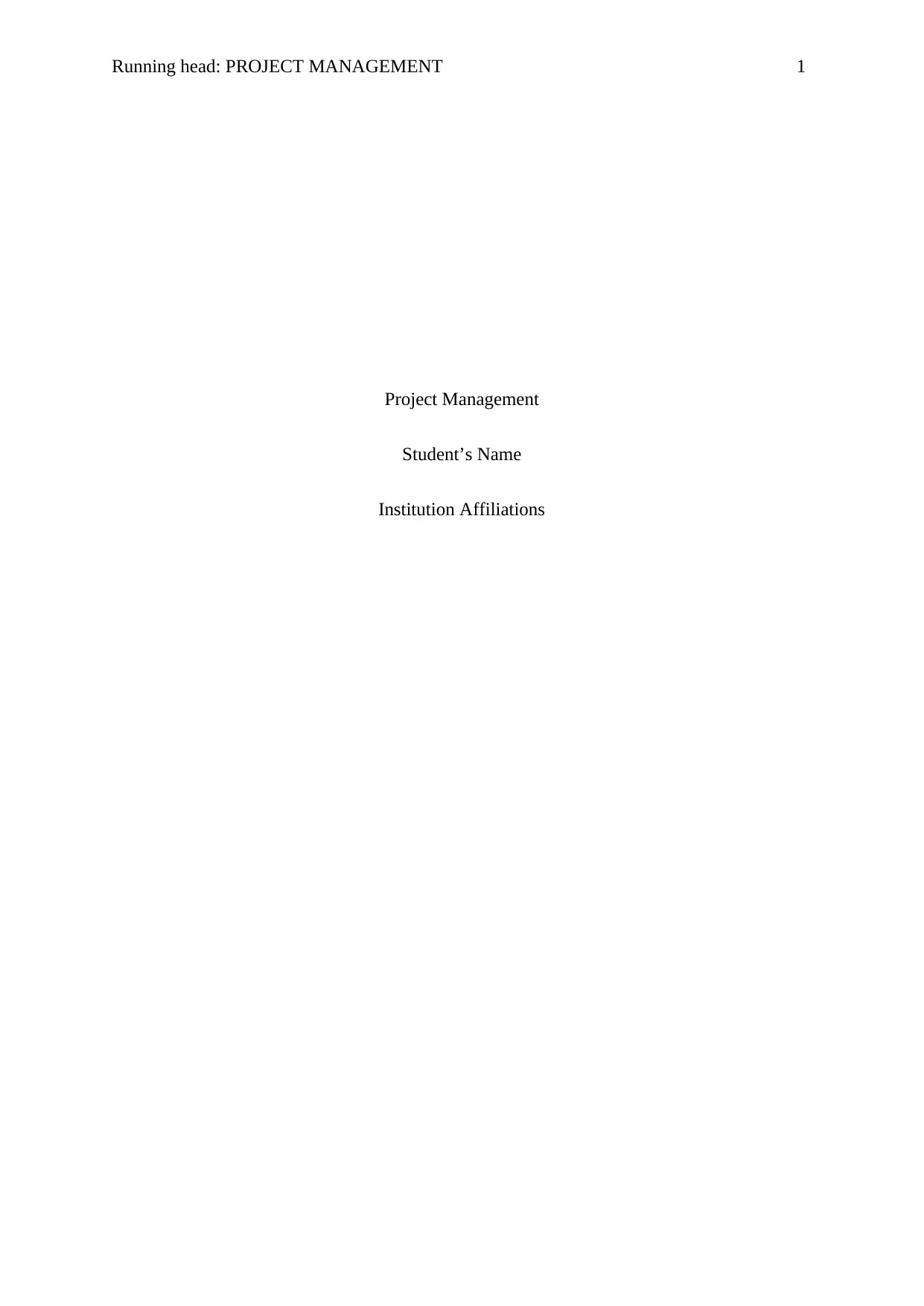
Running head: PROJECT MANAGEMENT 1
Project Management
Student’s Name
Institution Affiliations
Project Management
Student’s Name
Institution Affiliations
Paraphrase This Document
Need a fresh take? Get an instant paraphrase of this document with our AI Paraphraser
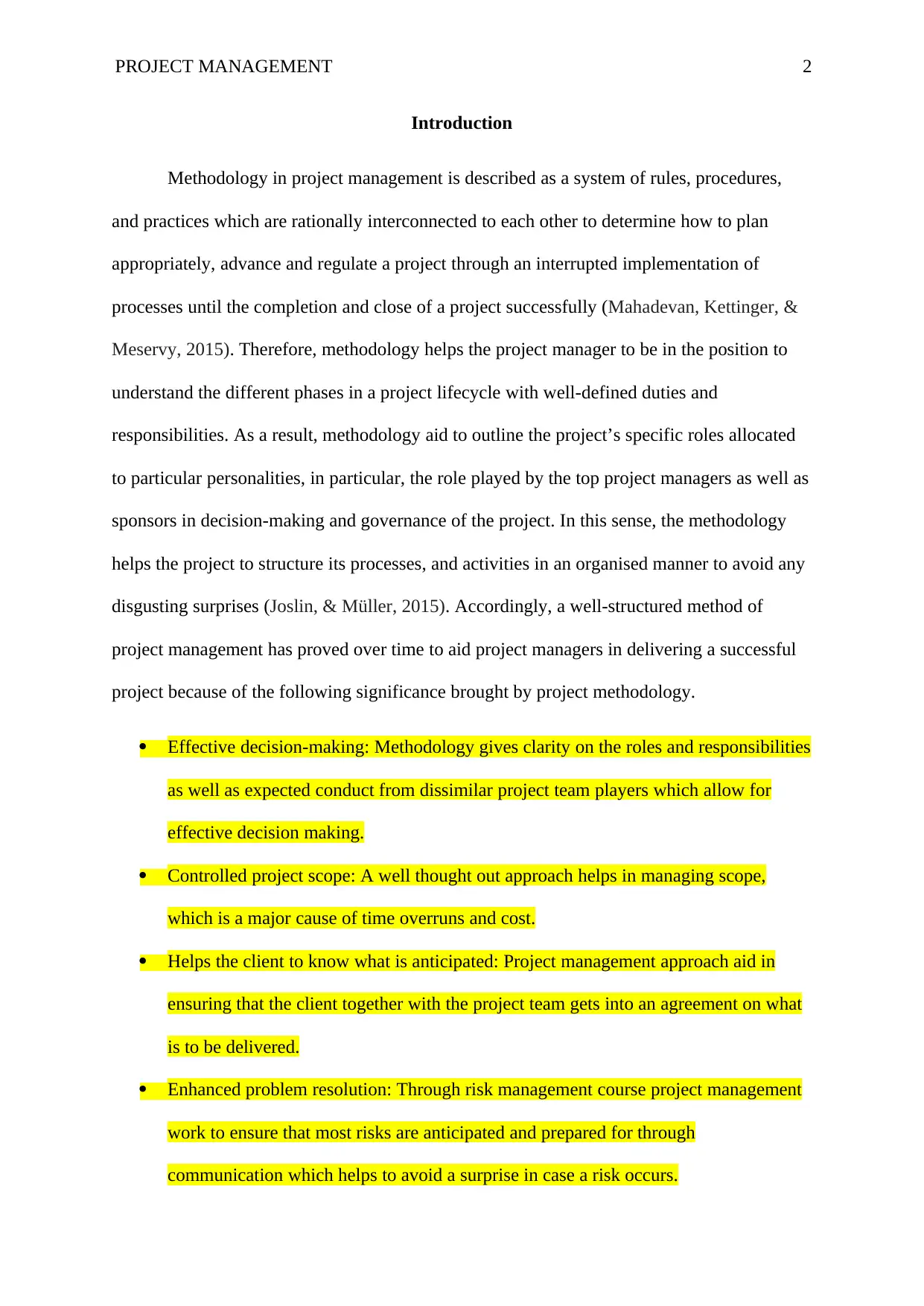
PROJECT MANAGEMENT 2
Introduction
Methodology in project management is described as a system of rules, procedures,
and practices which are rationally interconnected to each other to determine how to plan
appropriately, advance and regulate a project through an interrupted implementation of
processes until the completion and close of a project successfully (Mahadevan, Kettinger, &
Meservy, 2015). Therefore, methodology helps the project manager to be in the position to
understand the different phases in a project lifecycle with well-defined duties and
responsibilities. As a result, methodology aid to outline the project’s specific roles allocated
to particular personalities, in particular, the role played by the top project managers as well as
sponsors in decision-making and governance of the project. In this sense, the methodology
helps the project to structure its processes, and activities in an organised manner to avoid any
disgusting surprises (Joslin, & Müller, 2015). Accordingly, a well-structured method of
project management has proved over time to aid project managers in delivering a successful
project because of the following significance brought by project methodology.
Effective decision-making: Methodology gives clarity on the roles and responsibilities
as well as expected conduct from dissimilar project team players which allow for
effective decision making.
Controlled project scope: A well thought out approach helps in managing scope,
which is a major cause of time overruns and cost.
Helps the client to know what is anticipated: Project management approach aid in
ensuring that the client together with the project team gets into an agreement on what
is to be delivered.
Enhanced problem resolution: Through risk management course project management
work to ensure that most risks are anticipated and prepared for through
communication which helps to avoid a surprise in case a risk occurs.
Introduction
Methodology in project management is described as a system of rules, procedures,
and practices which are rationally interconnected to each other to determine how to plan
appropriately, advance and regulate a project through an interrupted implementation of
processes until the completion and close of a project successfully (Mahadevan, Kettinger, &
Meservy, 2015). Therefore, methodology helps the project manager to be in the position to
understand the different phases in a project lifecycle with well-defined duties and
responsibilities. As a result, methodology aid to outline the project’s specific roles allocated
to particular personalities, in particular, the role played by the top project managers as well as
sponsors in decision-making and governance of the project. In this sense, the methodology
helps the project to structure its processes, and activities in an organised manner to avoid any
disgusting surprises (Joslin, & Müller, 2015). Accordingly, a well-structured method of
project management has proved over time to aid project managers in delivering a successful
project because of the following significance brought by project methodology.
Effective decision-making: Methodology gives clarity on the roles and responsibilities
as well as expected conduct from dissimilar project team players which allow for
effective decision making.
Controlled project scope: A well thought out approach helps in managing scope,
which is a major cause of time overruns and cost.
Helps the client to know what is anticipated: Project management approach aid in
ensuring that the client together with the project team gets into an agreement on what
is to be delivered.
Enhanced problem resolution: Through risk management course project management
work to ensure that most risks are anticipated and prepared for through
communication which helps to avoid a surprise in case a risk occurs.
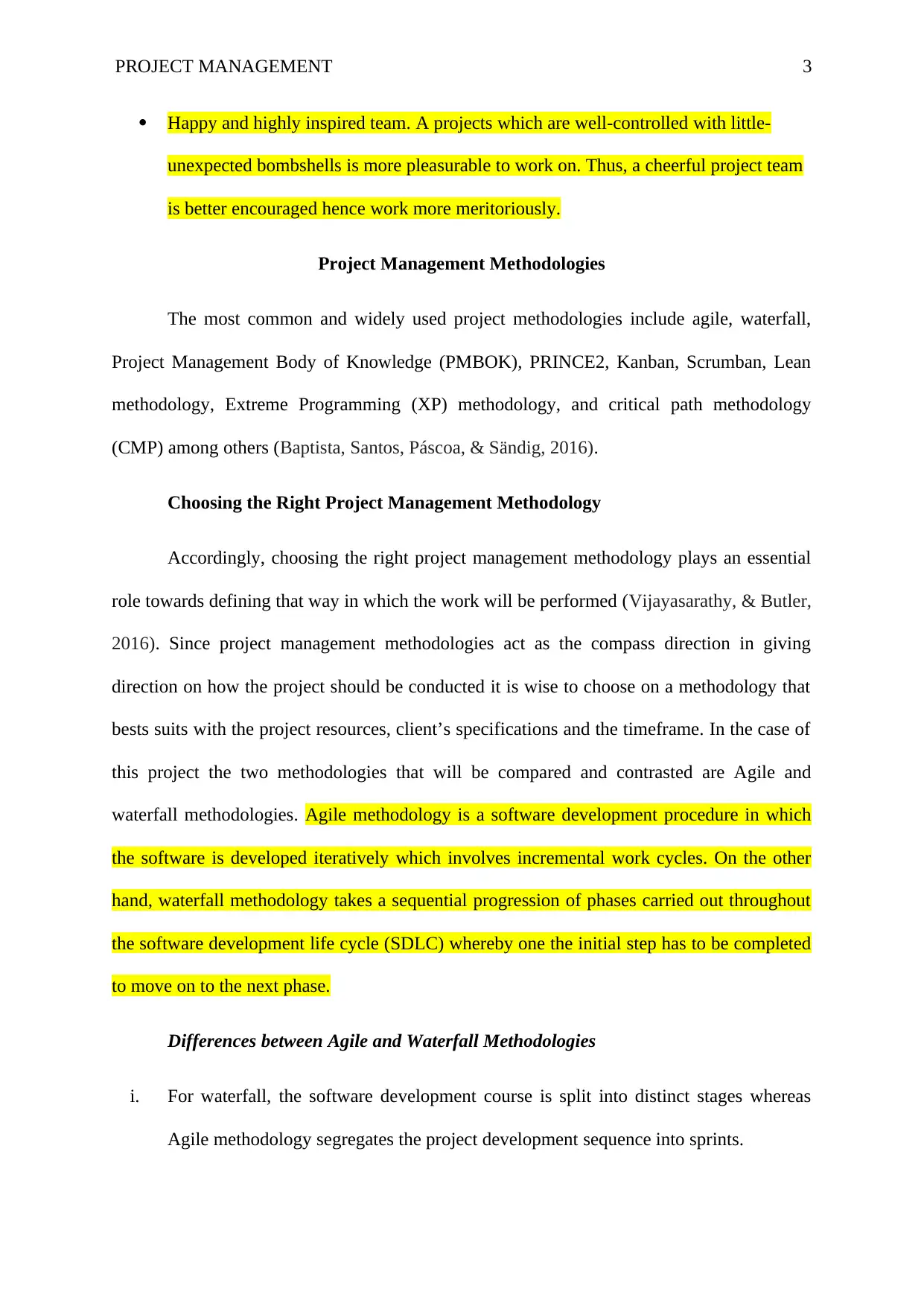
PROJECT MANAGEMENT 3
Happy and highly inspired team. A projects which are well-controlled with little-
unexpected bombshells is more pleasurable to work on. Thus, a cheerful project team
is better encouraged hence work more meritoriously.
Project Management Methodologies
The most common and widely used project methodologies include agile, waterfall,
Project Management Body of Knowledge (PMBOK), PRINCE2, Kanban, Scrumban, Lean
methodology, Extreme Programming (XP) methodology, and critical path methodology
(CMP) among others (Baptista, Santos, Páscoa, & Sändig, 2016).
Choosing the Right Project Management Methodology
Accordingly, choosing the right project management methodology plays an essential
role towards defining that way in which the work will be performed (Vijayasarathy, & Butler,
2016). Since project management methodologies act as the compass direction in giving
direction on how the project should be conducted it is wise to choose on a methodology that
bests suits with the project resources, client’s specifications and the timeframe. In the case of
this project the two methodologies that will be compared and contrasted are Agile and
waterfall methodologies. Agile methodology is a software development procedure in which
the software is developed iteratively which involves incremental work cycles. On the other
hand, waterfall methodology takes a sequential progression of phases carried out throughout
the software development life cycle (SDLC) whereby one the initial step has to be completed
to move on to the next phase.
Differences between Agile and Waterfall Methodologies
i. For waterfall, the software development course is split into distinct stages whereas
Agile methodology segregates the project development sequence into sprints.
Happy and highly inspired team. A projects which are well-controlled with little-
unexpected bombshells is more pleasurable to work on. Thus, a cheerful project team
is better encouraged hence work more meritoriously.
Project Management Methodologies
The most common and widely used project methodologies include agile, waterfall,
Project Management Body of Knowledge (PMBOK), PRINCE2, Kanban, Scrumban, Lean
methodology, Extreme Programming (XP) methodology, and critical path methodology
(CMP) among others (Baptista, Santos, Páscoa, & Sändig, 2016).
Choosing the Right Project Management Methodology
Accordingly, choosing the right project management methodology plays an essential
role towards defining that way in which the work will be performed (Vijayasarathy, & Butler,
2016). Since project management methodologies act as the compass direction in giving
direction on how the project should be conducted it is wise to choose on a methodology that
bests suits with the project resources, client’s specifications and the timeframe. In the case of
this project the two methodologies that will be compared and contrasted are Agile and
waterfall methodologies. Agile methodology is a software development procedure in which
the software is developed iteratively which involves incremental work cycles. On the other
hand, waterfall methodology takes a sequential progression of phases carried out throughout
the software development life cycle (SDLC) whereby one the initial step has to be completed
to move on to the next phase.
Differences between Agile and Waterfall Methodologies
i. For waterfall, the software development course is split into distinct stages whereas
Agile methodology segregates the project development sequence into sprints.
⊘ This is a preview!⊘
Do you want full access?
Subscribe today to unlock all pages.

Trusted by 1+ million students worldwide
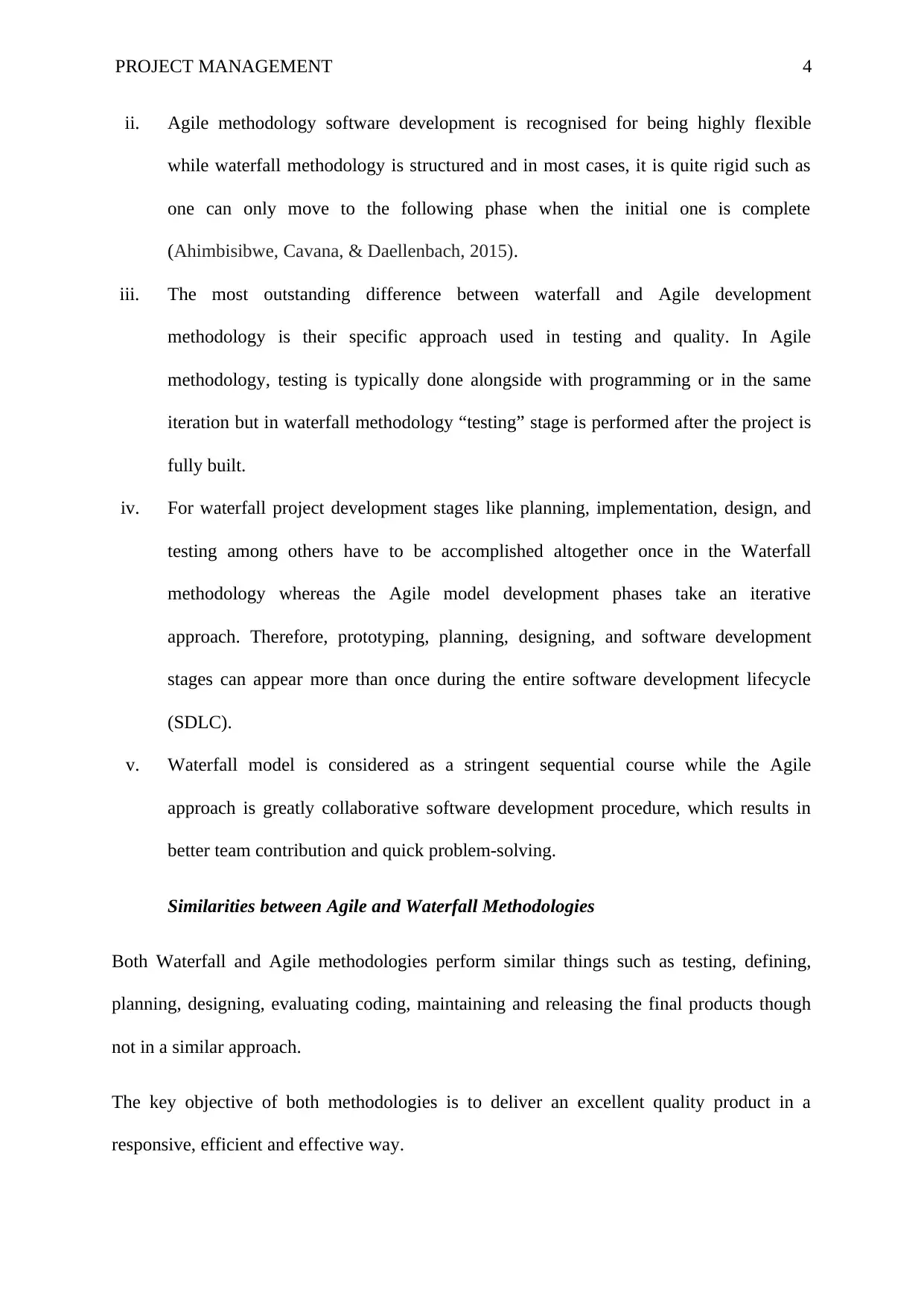
PROJECT MANAGEMENT 4
ii. Agile methodology software development is recognised for being highly flexible
while waterfall methodology is structured and in most cases, it is quite rigid such as
one can only move to the following phase when the initial one is complete
(Ahimbisibwe, Cavana, & Daellenbach, 2015).
iii. The most outstanding difference between waterfall and Agile development
methodology is their specific approach used in testing and quality. In Agile
methodology, testing is typically done alongside with programming or in the same
iteration but in waterfall methodology “testing” stage is performed after the project is
fully built.
iv. For waterfall project development stages like planning, implementation, design, and
testing among others have to be accomplished altogether once in the Waterfall
methodology whereas the Agile model development phases take an iterative
approach. Therefore, prototyping, planning, designing, and software development
stages can appear more than once during the entire software development lifecycle
(SDLC).
v. Waterfall model is considered as a stringent sequential course while the Agile
approach is greatly collaborative software development procedure, which results in
better team contribution and quick problem-solving.
Similarities between Agile and Waterfall Methodologies
Both Waterfall and Agile methodologies perform similar things such as testing, defining,
planning, designing, evaluating coding, maintaining and releasing the final products though
not in a similar approach.
The key objective of both methodologies is to deliver an excellent quality product in a
responsive, efficient and effective way.
ii. Agile methodology software development is recognised for being highly flexible
while waterfall methodology is structured and in most cases, it is quite rigid such as
one can only move to the following phase when the initial one is complete
(Ahimbisibwe, Cavana, & Daellenbach, 2015).
iii. The most outstanding difference between waterfall and Agile development
methodology is their specific approach used in testing and quality. In Agile
methodology, testing is typically done alongside with programming or in the same
iteration but in waterfall methodology “testing” stage is performed after the project is
fully built.
iv. For waterfall project development stages like planning, implementation, design, and
testing among others have to be accomplished altogether once in the Waterfall
methodology whereas the Agile model development phases take an iterative
approach. Therefore, prototyping, planning, designing, and software development
stages can appear more than once during the entire software development lifecycle
(SDLC).
v. Waterfall model is considered as a stringent sequential course while the Agile
approach is greatly collaborative software development procedure, which results in
better team contribution and quick problem-solving.
Similarities between Agile and Waterfall Methodologies
Both Waterfall and Agile methodologies perform similar things such as testing, defining,
planning, designing, evaluating coding, maintaining and releasing the final products though
not in a similar approach.
The key objective of both methodologies is to deliver an excellent quality product in a
responsive, efficient and effective way.
Paraphrase This Document
Need a fresh take? Get an instant paraphrase of this document with our AI Paraphraser
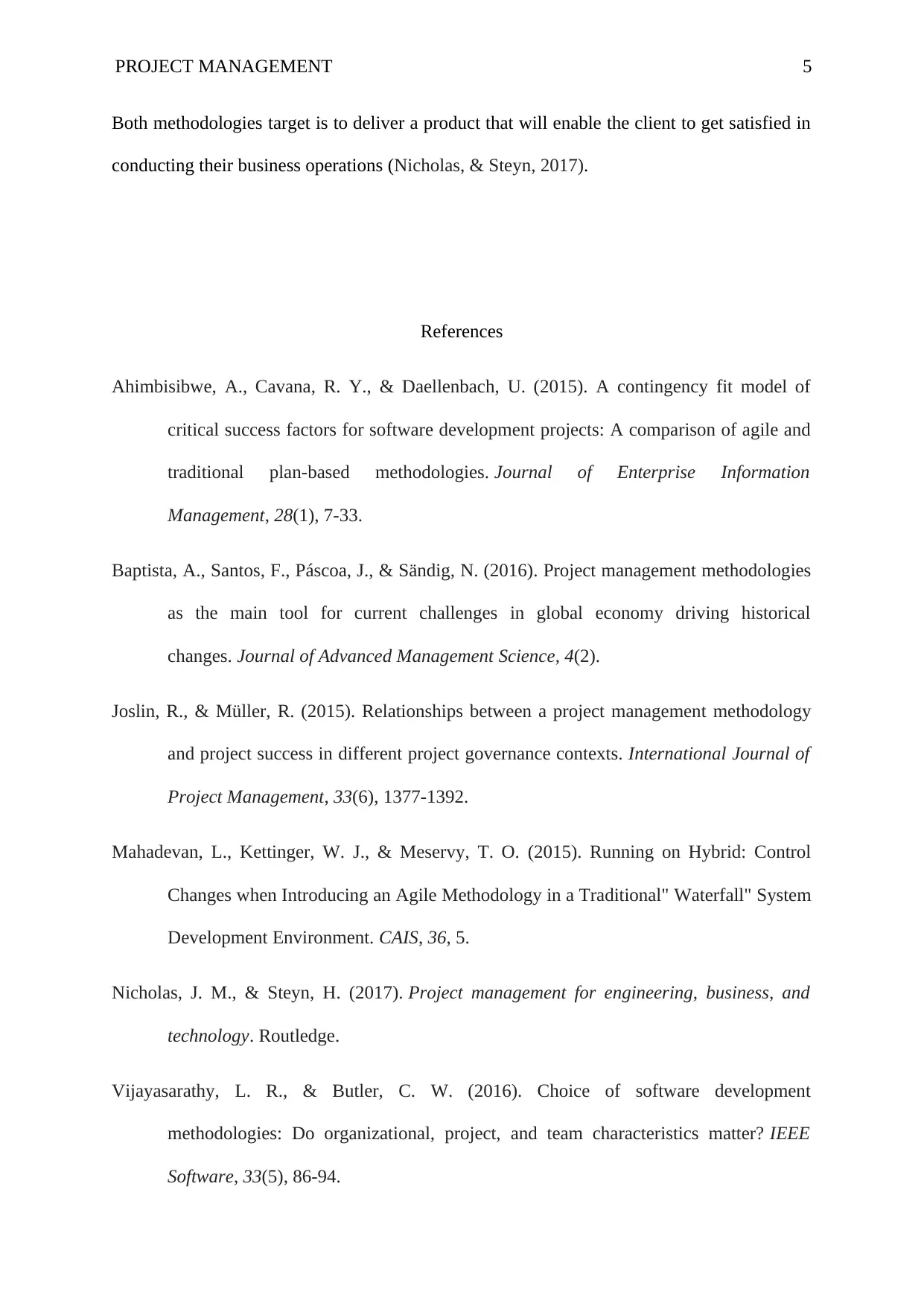
PROJECT MANAGEMENT 5
Both methodologies target is to deliver a product that will enable the client to get satisfied in
conducting their business operations (Nicholas, & Steyn, 2017).
References
Ahimbisibwe, A., Cavana, R. Y., & Daellenbach, U. (2015). A contingency fit model of
critical success factors for software development projects: A comparison of agile and
traditional plan-based methodologies. Journal of Enterprise Information
Management, 28(1), 7-33.
Baptista, A., Santos, F., Páscoa, J., & Sändig, N. (2016). Project management methodologies
as the main tool for current challenges in global economy driving historical
changes. Journal of Advanced Management Science, 4(2).
Joslin, R., & Müller, R. (2015). Relationships between a project management methodology
and project success in different project governance contexts. International Journal of
Project Management, 33(6), 1377-1392.
Mahadevan, L., Kettinger, W. J., & Meservy, T. O. (2015). Running on Hybrid: Control
Changes when Introducing an Agile Methodology in a Traditional" Waterfall" System
Development Environment. CAIS, 36, 5.
Nicholas, J. M., & Steyn, H. (2017). Project management for engineering, business, and
technology. Routledge.
Vijayasarathy, L. R., & Butler, C. W. (2016). Choice of software development
methodologies: Do organizational, project, and team characteristics matter? IEEE
Software, 33(5), 86-94.
Both methodologies target is to deliver a product that will enable the client to get satisfied in
conducting their business operations (Nicholas, & Steyn, 2017).
References
Ahimbisibwe, A., Cavana, R. Y., & Daellenbach, U. (2015). A contingency fit model of
critical success factors for software development projects: A comparison of agile and
traditional plan-based methodologies. Journal of Enterprise Information
Management, 28(1), 7-33.
Baptista, A., Santos, F., Páscoa, J., & Sändig, N. (2016). Project management methodologies
as the main tool for current challenges in global economy driving historical
changes. Journal of Advanced Management Science, 4(2).
Joslin, R., & Müller, R. (2015). Relationships between a project management methodology
and project success in different project governance contexts. International Journal of
Project Management, 33(6), 1377-1392.
Mahadevan, L., Kettinger, W. J., & Meservy, T. O. (2015). Running on Hybrid: Control
Changes when Introducing an Agile Methodology in a Traditional" Waterfall" System
Development Environment. CAIS, 36, 5.
Nicholas, J. M., & Steyn, H. (2017). Project management for engineering, business, and
technology. Routledge.
Vijayasarathy, L. R., & Butler, C. W. (2016). Choice of software development
methodologies: Do organizational, project, and team characteristics matter? IEEE
Software, 33(5), 86-94.

PROJECT MANAGEMENT 6
⊘ This is a preview!⊘
Do you want full access?
Subscribe today to unlock all pages.

Trusted by 1+ million students worldwide
1 out of 6
Related Documents
Your All-in-One AI-Powered Toolkit for Academic Success.
+13062052269
info@desklib.com
Available 24*7 on WhatsApp / Email
![[object Object]](/_next/static/media/star-bottom.7253800d.svg)
Unlock your academic potential
Copyright © 2020–2025 A2Z Services. All Rights Reserved. Developed and managed by ZUCOL.


